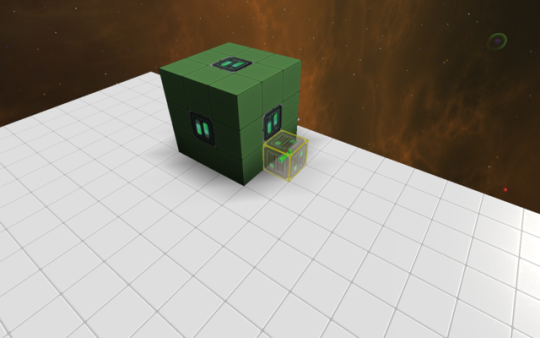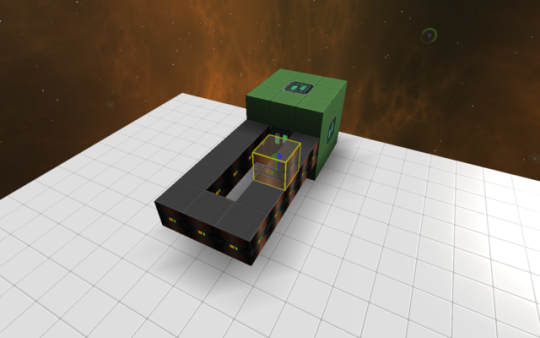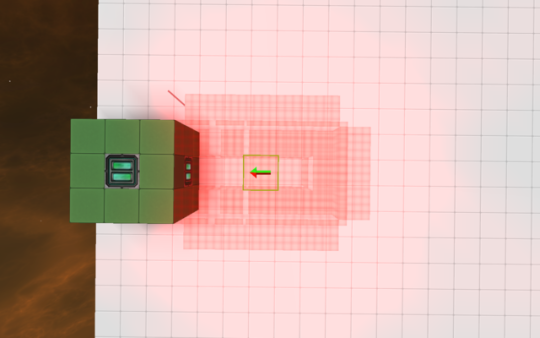- Joined
- Apr 26, 2017
- Messages
- 32
- Reaction score
- 14
Update 4/27/17: Added a reply below with images illustrating the concept hidden in spoilers
One of the criticisms of the Power Overhaul proposal was figuring out where the heat boxes were actually going to go, and managing a heat box on a non-rectangular craft. I recognize that HEAT might not be the final name for this resource, this could end up being Electrical interference or radiation instead.
What made the most sense to me was to allow the player to draw-out where the heat box was going to generate using Heatsink blocks. Here are two proposals for how this block could function.
1: Heatsink blocks must be placed as a continuous group, attaching to the reactor, and radiate heat a number of blocks in all directions from themselves. Each space that is radiated adds to your heat dissipation score, and a reactor with an insufficient heat dissipation score gets "backed up" and suffers a steep loss in output. The heatsink blocks themselves do NOT count towards your heat dissipation score, only the blocks or empty space they radiate. Selecting a heatsink block group should show you the radiation area, and highlight any system blocks that will be affected by the heat zone.
The size of the radiation zone generated by the Heatsink blocks is determined by the size of your reactor. A larger reactor causes each heat sink block to radiate a much larger area, allowing players to build ship interiors where they cannot actually see the heat sink blocks, but where all of the interior is being scored for heat dissipation (by placing a heat sink track outside the perimeter of a common room in-between the walls, or down the middle of a corridor). A smaller ship will require drastically less heat dissipation, and the heatsink blocks would project a radiation area of only one or two blocks, encouraging a more cramped interior for an efficient design.
The heatsink blocks themselves could be fairly low mass, but there would be tradeoffs to denser or looser heat dissipation shapes. A denser shape will be less efficient, since the blocks themselves aren't counted towards the heat dissipation score, but it would be more durable against attack. A more loose shape would be more efficient, but any time heat sink blocks are no longer connected continuously (when part of a loop is broken away), the disconnected blocks no longer generate radiation areas and no longer contribute to the heat dissipation score, creating a backup and potentially disabling or overheating the ship.
This allows Heatsink blocks to be palced in tubes throughout the ship, blades protruding from a ship, or all manner of in-between. This would be the ideal system. It would offer the most flexibility but would probably be challenging to code/implement.
2: Heatsink blocks could be used to form the boundries of the heat box in the same way that shipyards and jump gates create areas. Selecting the heatsink block group would reveal the heat box, and highlight any systems that would be affected by it. Reactors would have a minimum heat dissipation score, and the size of that highighted area would need to meet or exceed that score or it would become "Backed up" and suffer a steep loss in output. The biggest downside with this design is that the "guts" of the heat dissipation would need to effectively line the inside of the ship, exposing it to attack. If it were written the same way that shipyards are, a small amount of damage to the heatsink blocks would cause the shape to become invalid and you would immediately have a backup. This system would not be ideal, but it might be simpler to implement.
One of the criticisms of the Power Overhaul proposal was figuring out where the heat boxes were actually going to go, and managing a heat box on a non-rectangular craft. I recognize that HEAT might not be the final name for this resource, this could end up being Electrical interference or radiation instead.
What made the most sense to me was to allow the player to draw-out where the heat box was going to generate using Heatsink blocks. Here are two proposals for how this block could function.
1: Heatsink blocks must be placed as a continuous group, attaching to the reactor, and radiate heat a number of blocks in all directions from themselves. Each space that is radiated adds to your heat dissipation score, and a reactor with an insufficient heat dissipation score gets "backed up" and suffers a steep loss in output. The heatsink blocks themselves do NOT count towards your heat dissipation score, only the blocks or empty space they radiate. Selecting a heatsink block group should show you the radiation area, and highlight any system blocks that will be affected by the heat zone.
The size of the radiation zone generated by the Heatsink blocks is determined by the size of your reactor. A larger reactor causes each heat sink block to radiate a much larger area, allowing players to build ship interiors where they cannot actually see the heat sink blocks, but where all of the interior is being scored for heat dissipation (by placing a heat sink track outside the perimeter of a common room in-between the walls, or down the middle of a corridor). A smaller ship will require drastically less heat dissipation, and the heatsink blocks would project a radiation area of only one or two blocks, encouraging a more cramped interior for an efficient design.
The heatsink blocks themselves could be fairly low mass, but there would be tradeoffs to denser or looser heat dissipation shapes. A denser shape will be less efficient, since the blocks themselves aren't counted towards the heat dissipation score, but it would be more durable against attack. A more loose shape would be more efficient, but any time heat sink blocks are no longer connected continuously (when part of a loop is broken away), the disconnected blocks no longer generate radiation areas and no longer contribute to the heat dissipation score, creating a backup and potentially disabling or overheating the ship.
This allows Heatsink blocks to be palced in tubes throughout the ship, blades protruding from a ship, or all manner of in-between. This would be the ideal system. It would offer the most flexibility but would probably be challenging to code/implement.
2: Heatsink blocks could be used to form the boundries of the heat box in the same way that shipyards and jump gates create areas. Selecting the heatsink block group would reveal the heat box, and highlight any systems that would be affected by it. Reactors would have a minimum heat dissipation score, and the size of that highighted area would need to meet or exceed that score or it would become "Backed up" and suffer a steep loss in output. The biggest downside with this design is that the "guts" of the heat dissipation would need to effectively line the inside of the ship, exposing it to attack. If it were written the same way that shipyards are, a small amount of damage to the heatsink blocks would cause the shape to become invalid and you would immediately have a backup. This system would not be ideal, but it might be simpler to implement.
Last edited:





